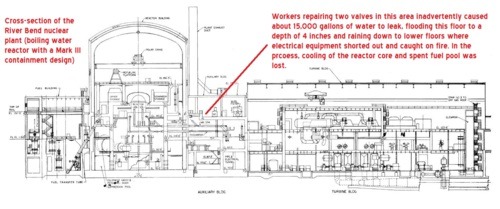Workers at the River Bend nuclear plant near Baton Rouge, Louisiana had to repair two manual isolation valves in the cooling water piping that connected to equipment in the auxiliary building.
The valves needed to be removed from the piping for the maintenance. But there were no valves located upstream of these valves that could be closed so the downstream piping could be drained to allow their removal. And the workers couldn’t just shut down and drain the entire cooling water system because it also supplied other essential safety components. They needed to isolate and drain only a small portion of the cooling water system.The River Benders opted for a freeze seal in the piping to the component. They placed a special blanket around the 6-inch diameter piping. Liquid nitrogen at a temperature well below 0°F flowed through the blanket to quickly freeze the water in the piping, stopping its flow. They drained the piping downstream of the ice plug and removed the two valves.
The freeze seal failed on April 19, 1989, when the flow of nitrogen through the blanket stopped. A standard precaution when using freeze seals – monitoring the frozen plug’s temperature – had not been followed. Thus, workers did not realize that the ice plug was melting until it failed. The problem then became readily apparent, since about 15,000 gallons of water flowed from the piping through the holes where the valves had been removed.
The water flooded an upper floor of the auxiliary building to a depth of about four inches. (See the leak’s location in the figure below.) Water seeped through holes in the floor and into electrical cabinets on the floor below. The water shorted these electrical circuits and started a fire. As a result of the short circuits and the fire, cooling of the irradiated fuel assemblies in the reactor core was lost. The lights in the auxiliary building, control building, and reactor building went out. Operators stopped the flow of water through the unfrozen seal within 15 minutes and restored core cooling about two minutes later. They soon had the fire out, too.
 (Click figure for a larger version)
(Click figure for a larger version)
Two years earlier, workers at the Oconee Unit 1 reactor in South Carolina had similar misfortune. They wrapped a nitrogen blanket around a 3-inch diameter pipe connected to the borated water storage tank and started the liquid nitrogen flow. When the ice plug later thawed out, nearly 30,000 gallons of slightly contaminated water leaked into the auxiliary building. It took the Oconee gang about eight hours to stop the leak. The water flooded portions of the auxiliary building. Some of the water made its way into the plant’s storm sewers and carried its radioactivity to the environment.
The problem caused by ice melting does not just affect nuclear plants in the United States. Ice doesn’t play favorites – it melts above 32°F, or 0°C, here, there, and everywhere.
On March 14, 1980, workers at the Tarapur nuclear plant in India applied a freeze seal using liquid nitrogen on a section of piping connected to the reactor vessel. The ice plug thawed out and was pushed out the open end of the piping. Workers scrambled to install a temporary plug in the piping that was held in position by chains. The water level in the reactor vessel dropped towards the irradiated fuel assemblies as water poured out through the piping until the temporary plug was installed in the nick of time.
Our Takeaway
The NRC looked into these events, and a few others. The NRC estimated that a freeze seal failure could cause the irradiated fuel assemblies in reactor cores to be uncovered in less than an hour. Uncovering a reactor core is bad, whether in less than an hour or more than four hours. The clock reference merely suggests how little time workers had to intervene to prevent disaster from happening. But instead of banning the risky practice, the NRC simply encouraged folks to be very careful when they freeze pipes.
What the NRC should have done then and should do now is enforce regulations specifically designed to protect workers and the public in these cases. Section 50.59 in Title 10 of the Code of Federal Regulations requires plant owners to seek prior NRC permission before undertaking any activity that reduces the pre-established safety margins. The operating licenses issued by the NRC for nuclear plants do not authorize workers to use freeze seals to prevent water from draining out of the reactor vessel and uncovering the reactor core. The operating licenses rely on design features, such as isolation valves that can be closed, for this safety function.
Thus, any plant owner wanting to use a freeze seal instead is required – by this federal regulation – to obtain express NRC approve before doing it. This measure, when followed, gives the NRC the ability to withhold its approval until assured that the owner has developed proper controls to prevent the freeze seal’s failure as well as contingency measures to successfully respond to a failure if it occurs anyway.
The world would be a far better place if the NRC enforced its regulations in addition to encouraging plant owners to be careful.
“Fission Stories” is a weekly feature by Dave Lochbaum. For more information on nuclear power safety, see the nuclear safety section of UCS’s website and our interactive map, the Nuclear Power Information Tracker.
